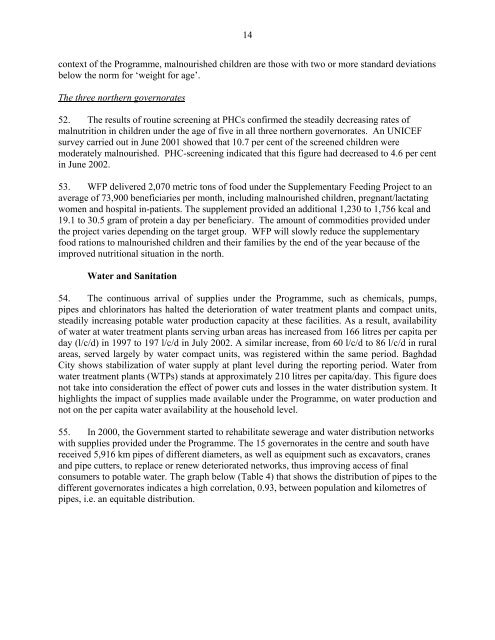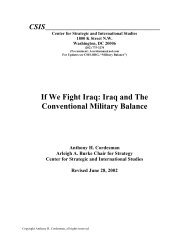I. Introduction II. Revenue generation
I. Introduction II. Revenue generation
I. Introduction II. Revenue generation
You also want an ePaper? Increase the reach of your titles
YUMPU automatically turns print PDFs into web optimized ePapers that Google loves.
14context of the Programme, malnourished children are those with two or more standard deviationsbelow the norm for ‘weight for age’.The three northern governorates52. The results of routine screening at PHCs confirmed the steadily decreasing rates ofmalnutrition in children under the age of five in all three northern governorates. An UNICEFsurvey carried out in June 2001 showed that 10.7 per cent of the screened children weremoderately malnourished. PHC-screening indicated that this figure had decreased to 4.6 per centin June 2002.53. WFP delivered 2,070 metric tons of food under the Supplementary Feeding Project to anaverage of 73,900 beneficiaries per month, including malnourished children, pregnant/lactatingwomen and hospital in-patients. The supplement provided an additional 1,230 to 1,756 kcal and19.1 to 30.5 gram of protein a day per beneficiary. The amount of commodities provided underthe project varies depending on the target group. WFP will slowly reduce the supplementaryfood rations to malnourished children and their families by the end of the year because of theimproved nutritional situation in the north.Water and Sanitation54. The continuous arrival of supplies under the Programme, such as chemicals, pumps,pipes and chlorinators has halted the deterioration of water treatment plants and compact units,steadily increasing potable water production capacity at these facilities. As a result, availabilityof water at water treatment plants serving urban areas has increased from 166 litres per capita perday (l/c/d) in 1997 to 197 l/c/d in July 2002. A similar increase, from 60 l/c/d to 86 l/c/d in ruralareas, served largely by water compact units, was registered within the same period. BaghdadCity shows stabilization of water supply at plant level during the reporting period. Water fromwater treatment plants (WTPs) stands at approximately 210 litres per capita/day. This figure doesnot take into consideration the effect of power cuts and losses in the water distribution system. Ithighlights the impact of supplies made available under the Programme, on water production andnot on the per capita water availability at the household level.55. In 2000, the Government started to rehabilitate sewerage and water distribution networkswith supplies provided under the Programme. The 15 governorates in the centre and south havereceived 5,916 km pipes of different diameters, as well as equipment such as excavators, cranesand pipe cutters, to replace or renew deteriorated networks, thus improving access of finalconsumers to potable water. The graph below (Table 4) that shows the distribution of pipes to thedifferent governorates indicates a high correlation, 0.93, between population and kilometres ofpipes, i.e. an equitable distribution.
















